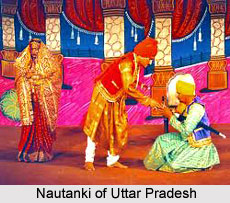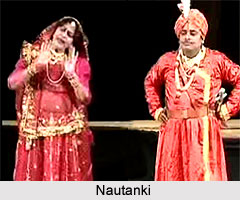 Themes in Nautanki, are varied and add significant dimension to the folk theatre of Uttar Pradesh. Nautanki, secular to the roots, is a beautiful blend of the Hindu-Muslim folk cultures. Its language, music, costumes, themes and characters reflect the mixed social set-up.
Themes in Nautanki, are varied and add significant dimension to the folk theatre of Uttar Pradesh. Nautanki, secular to the roots, is a beautiful blend of the Hindu-Muslim folk cultures. Its language, music, costumes, themes and characters reflect the mixed social set-up.
The austere Muslims who came as conquerors in the eleventh and twelfth centuries slowly adopted the ways of local Hindus, and the Hindus slowly accepted Muslim influence in their arts. During the long Mughal rule, the arts reflected a synthesis of the two cultures. The classical Kathak dancers, steeped in Radha-Krishna lore, are dressed in Persian tunics and girdles. The miniatures paintings in Rajasthan of the sixteenth to the eighteenth centuries are an expression of the gilded refinement of Mughal courts and Hindu myths and legends. The Nautanki also manifests the vitality of the two cultures.
Religious tales digested in the Nautanki have a secular colouring. The Nautankis were mostly written in personalized Urdu language with a mixture of cultures from Braj, Hindi and Rajasthan. The courtly language of the Nautankis required the composer to select ornate music and to draw from the classical ragas. In actual singing, they made the ragas more folk. The chief regional variants of the classical ragas are Bhairavi, Bilawal, Peelu and Kamaj. The Nautanki singing does not offer musical elaboration. It gives the classical melody directness, an edge, a rural vigour.
The story from which Nautaki takes the name tells of Princess Nautani of Multan, a famous beauty. In a neighbouring state lived two brothers, Bhup Singh and Phool Singh. One day the younger, Phool Singh- handsome, adventurous, and rash- returns from hunting and asks his brother`s wife to serve him food quickly. She taunts him saying that he is behaving as if he were the husband of the beautiful Nautanki. Insulted, he leaves home, vowing that he will not return until he has married Nautanki. His faithful friend, Yashwant Singh, accompanies him. On reaching Multan, they meet the flower woman of the palace and beg her to allow them to stay in her hut. Every day this flower woman carries a garland of fresh flowers to the princess. Phool Singh, expert in the art of floral decoration, offers to weave a garland for the prince if his hostess will cook for him. The flower woman takes the garland to the princess, who suspects that someone else has prepared it and flies into a rage. The terrified flower woman explains that her nephew`s young wife has been on a short visit and that she had prepared the garland. The princess commands her to produce the young wife and the flower woman returns to her hut greatly perturbed. Phool Singh calms her, suggesting that he is a superb disguiser and will not be recognized if he puts on a woman`s clothes. The flower woman takes Phool Singh, disguised as a beautiful woman, to the princess, who is stuck by his beauty. She offers her friendship and insists that Phool singh stay in her chamber. He agrees. At night the princess sighs that if Phool Singh was a man, she would marry him. Phool Singh asks her to close her eyes, meditate and concentrate on the household deity and invoke her blessings to turn one of them into a man. This the princess does, and when she opens her eyes, she finds that her friend has turned into a man. A love scene follows. In the morning the palace maid reports the matter to the king, who orders the young man arrested and killed. Nautanki, carrying a sword and cup of poison, reaches the spot where Phool Singh is awaiting death. She drives off the executioners and challenges her father. The king, deeply touched, agrees to her marriage with Phool Singh.
 Nautanki and Phool Singh have entered the vocabulary of the folk speech. Any beautiful girl dismissing her suitors one after the other is a Nautanki waiting for her Phool Singh. Hundreds of plays have been written on the theme. Most troupes have the story of Shehzadi Nautanki in their repertoire.
Nautanki and Phool Singh have entered the vocabulary of the folk speech. Any beautiful girl dismissing her suitors one after the other is a Nautanki waiting for her Phool Singh. Hundreds of plays have been written on the theme. Most troupes have the story of Shehzadi Nautanki in their repertoire.
Siyah Posh is another popular tale. Jamal, daughter of the Wazir of Syria is reading the Holy Qaran on her palace balcony when handsome young Gabru passes the street and points out the mistakes in her recital. Jamal looks at him and invites him to continue correcting her. He scales the palace wall, and they fall in love. Every night he meets her in her chamber. One night, while scaling the wall, he is arrested, and the Wazir orders his execution. Jamal, dressed in a black mask, arrives at the scene. The king, who has overheard their conversation, on one of his nightly incognito rounds, recognizes the purity of their love and pardons them. Struck by Jamal`s nobility and faithful love, he adopts her as a daughter and marries her to Gabru, who is proclaimed heir to the throne.
Raja Harischandra is the story of an ancient Hindu King who is steadfast in honouring his words. The story has been celebrated in ballads, plays, musical dramas and poems all over India. Films have been made from the theme. Every Indian child knows the story and is moved by the scene of Queen Taramati walking in the street with her son`s dead body in her arms.
An important 19th Century musical drama was Indrasabha ("The Court of God Indra") by Agha Hassab Amanat, the Urdu poet of Lucknow. Amanat used traditional melodies, folk tunes and seasonal dances, adding to these, his dramatic lyric talent. The operatic play went into many editions during his lifetime. Every professional theatrical company during the second half of the 19th century staged Indrasabha. Various Nautanki troupes modified the original to include their local myths, characters, situations and melodies. Indrasabha stands between literary drama and folk play. Its popularity invigorated Nautanki writers, who sought to emulate its whimsical and other worldly atmosphere of fairies, devils, gods, princes, wizards and dancers.
Nautanki stories are full of noble bandits, brave fighters and truthful lovers. They emphasize courage, nobility and gallantry. Events take place at fast pace. Gods, wizards and nymphs have free social intercourse with Kings, palace maids, robbers and landlords creating a fanciful world with intense appeal.
The language is simple, direct and strong. It has no literary density. In the mid 19th Century, Urdu had already become a definite language because of court patronage and the tradition of sophisticated poetic symposia. The Nautanki writers cast off the heavily-padded Hindi vocabulary and employed chiefly the more plastic Urdu. The opening prayer song, Mangalacharana, is invariably in Sanskritised Hindi because of its religious atmosphere.
The costumes do not belong to a definite period. King Harischandra wears the 17th Century gilded tunic, while Queen Taramati appears in contemporary sarees. The romantic hero struts in a velvet coat of Western style; the heroine flaunts a sari or a silken lehnga (loose flowing skirt).
Women, acted by men, use bright make-ups - apply face powder and mark cheeks and forehead with red dots and silver moons. Lamb soot accents the eyes. Nose rings, ear rings, bracelets and ankle bells add glitter.
Munshiji, the Clown, wears a coat button backward, with a patched multi-coloured shirt and trousers, and carries a split bamboo in his hand. Munshiji means "accountant of the household". He was a popular in the 19th Century palaces of Nawabs and landlords, always appearing at an unfortunate moments to remind the mistress of the accounts. Knowing the seamy side of life, Munshiji moved among the cuckolds, disguised lovers, mistresses and gallant warriors, breaking the serious mood by his financial logic. He appears in Nautanki as an all knowing man whose incongruous remarks make people laugh. Sometimes he wears a hat or a Turkish cap. He can wear any absurd costume, make any crazy remark, and appear at any moment whenever the play drags he enters, bringing in a splash of colours.



















